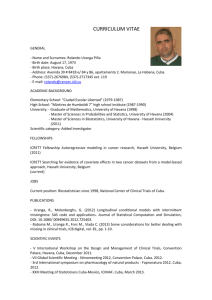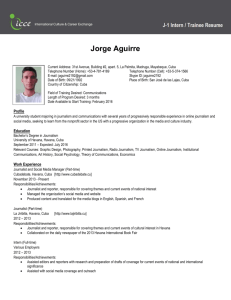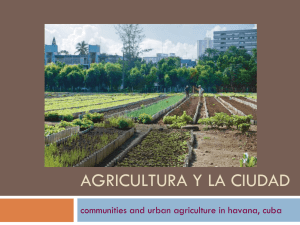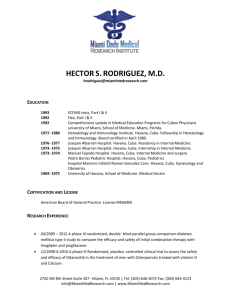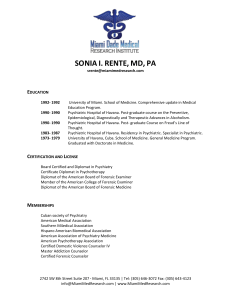Botanica de Cuba
advertisement
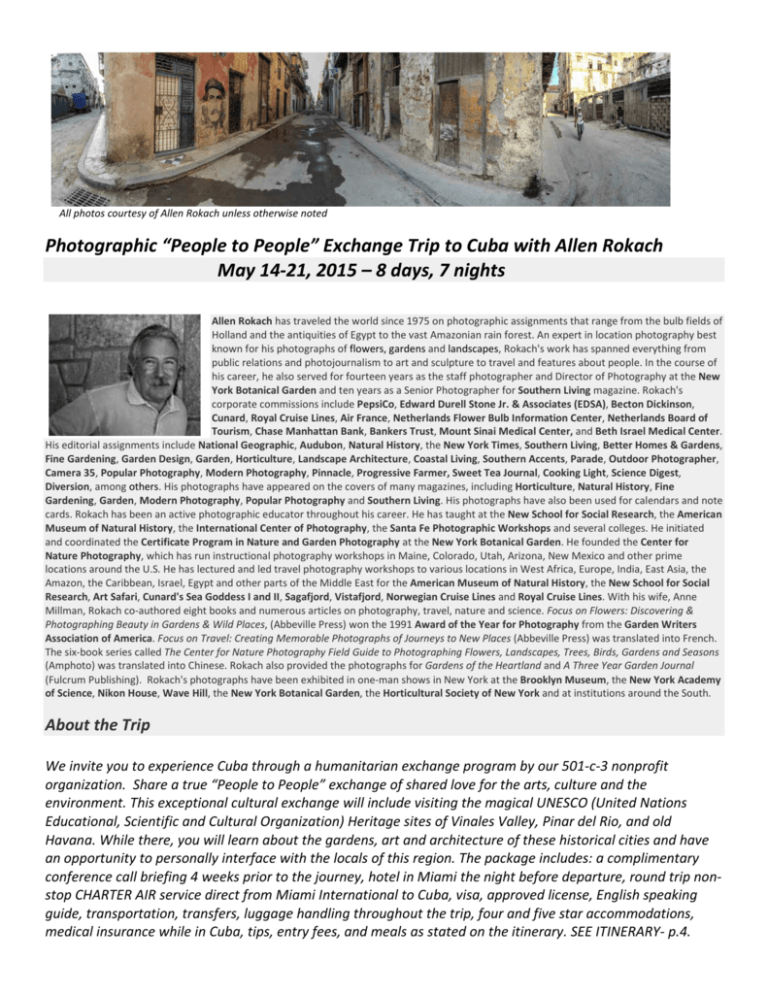
All photos courtesy of Allen Rokach unless otherwise noted Photographic “People to People” Exchange Trip to Cuba with Allen Rokach May 14-21, 2015 – 8 days, 7 nights Allen Rokach has traveled the world since 1975 on photographic assignments that range from the bulb fields of Holland and the antiquities of Egypt to the vast Amazonian rain forest. An expert in location photography best known for his photographs of flowers, gardens and landscapes, Rokach's work has spanned everything from public relations and photojournalism to art and sculpture to travel and features about people. In the course of his career, he also served for fourteen years as the staff photographer and Director of Photography at the New York Botanical Garden and ten years as a Senior Photographer for Southern Living magazine. Rokach's corporate commissions include PepsiCo, Edward Durell Stone Jr. & Associates (EDSA), Becton Dickinson, Cunard, Royal Cruise Lines, Air France, Netherlands Flower Bulb Information Center, Netherlands Board of Tourism, Chase Manhattan Bank, Bankers Trust, Mount Sinai Medical Center, and Beth Israel Medical Center. His editorial assignments include National Geographic, Audubon, Natural History, the New York Times, Southern Living, Better Homes & Gardens, Fine Gardening, Garden Design, Garden, Horticulture, Landscape Architecture, Coastal Living, Southern Accents, Parade, Outdoor Photographer, Camera 35, Popular Photography, Modern Photography, Pinnacle, Progressive Farmer, Sweet Tea Journal, Cooking Light, Science Digest, Diversion, among others. His photographs have appeared on the covers of many magazines, including Horticulture, Natural History, Fine Gardening, Garden, Modern Photography, Popular Photography and Southern Living. His photographs have also been used for calendars and note cards. Rokach has been an active photographic educator throughout his career. He has taught at the New School for Social Research, the American Museum of Natural History, the International Center of Photography, the Santa Fe Photographic Workshops and several colleges. He initiated and coordinated the Certificate Program in Nature and Garden Photography at the New York Botanical Garden. He founded the Center for Nature Photography, which has run instructional photography workshops in Maine, Colorado, Utah, Arizona, New Mexico and other prime locations around the U.S. He has lectured and led travel photography workshops to various locations in West Africa, Europe, India, East Asia, the Amazon, the Caribbean, Israel, Egypt and other parts of the Middle East for the American Museum of Natural History, the New School for Social Research, Art Safari, Cunard's Sea Goddess I and II, Sagafjord, Vistafjord, Norwegian Cruise Lines and Royal Cruise Lines. With his wife, Anne Millman, Rokach co-authored eight books and numerous articles on photography, travel, nature and science. Focus on Flowers: Discovering & Photographing Beauty in Gardens & Wild Places, (Abbeville Press) won the 1991 Award of the Year for Photography from the Garden Writers Association of America. Focus on Travel: Creating Memorable Photographs of Journeys to New Places (Abbeville Press) was translated into French. The six-book series called The Center for Nature Photography Field Guide to Photographing Flowers, Landscapes, Trees, Birds, Gardens and Seasons (Amphoto) was translated into Chinese. Rokach also provided the photographs for Gardens of the Heartland and A Three Year Garden Journal (Fulcrum Publishing). Rokach's photographs have been exhibited in one-man shows in New York at the Brooklyn Museum, the New York Academy of Science, Nikon House, Wave Hill, the New York Botanical Garden, the Horticultural Society of New York and at institutions around the South. About the Trip We invite you to experience Cuba through a humanitarian exchange program by our 501-c-3 nonprofit organization. Share a true “People to People” exchange of shared love for the arts, culture and the environment. This exceptional cultural exchange will include visiting the magical UNESCO (United Nations Educational, Scientific and Cultural Organization) Heritage sites of Vinales Valley, Pinar del Rio, and old Havana. While there, you will learn about the gardens, art and architecture of these historical cities and have an opportunity to personally interface with the locals of this region. The package includes: a complimentary conference call briefing 4 weeks prior to the journey, hotel in Miami the night before departure, round trip nonstop CHARTER AIR service direct from Miami International to Cuba, visa, approved license, English speaking guide, transportation, transfers, luggage handling throughout the trip, four and five star accommodations, medical insurance while in Cuba, tips, entry fees, and meals as stated on the itinerary. SEE ITINERARY- p.4. There’s plenty to do & see if you are not a photographer. Not included: Cuba departure tax of $30.00, tips for guides and driver, baggage fees charged in Miami. We travel on a US Department of Treasury approved license and visa. There are a limited number of seats available for this rare chance to visit this distinctive island. Leave the rest to our knowledgeable and experienced professionals! Trip dates are May 14-21, 2016 8 days, 7 nights Price: $3999.00 per person double occupancy (Add $450.00 for single supplemental) Collect the Color! Click till you Collapse! Capture Cuba! To sign up, please fill out page 2 and mail with a $500.00 deposit. Trip Application Form Instructions: In order to make your reservation and hold a space, fill out the trip application below and send it along with a non- binding $500.00* deposit per person. (Checks only, please.) MARK YOUR CHECK MEMO- Rokach May trip . The check is to be made out to: Florida Keys TREE Institute (a 501-c-3, non- profit organization). Mail your deposit check and the application form to: FK TREE Institute- 1850 SW 8th St. Suite 204A, Miami, FL 33135. You will receive a confirmation via email. Questions? Contact: info@fktreeinstitute.org 866- 355-8733 (866-FLK- TREE) Name _____________________________________________________ Address ____________________________________________________ Cell Phone ________________________ email ______________________________________ Single_____ ($500.00 deposit) Double ______ rooming with _________________________________ ($1,000.00 deposit) Roommate’s Name ______________________________________ Roommate’s cell phone ______________ email _______________________________________ ****************************************************************************** Other notes: We take care of getting your documentation, visas and all reservations starting in Miami. The Miami hotel the night before departing to Cuba is included. You are responsible for getting to Miami. The trip deposit is refundable* up until March 1, 2016. We will confirm receipt of your deposit. On or about Feb 1, 2016, we will email you a registration packet and instructions which will be due with final payment by March 14, 2016. It will also include information for optional trip cancellation/interruption insurance. (This package includes medical coverage while in Cuba.) CHECK YOUR PASSPORT NOW. IT MUST BE GOOD THROUGH November 22, 2016. About one month prior to the trip, we will have a required toll free conference call to go over all the information for traveling to Cuba. The Board of FK TREE Institute has been conducting legalized trips to Cuba for over a decade and has been actively doing environmental and cultural projects throughout the country. *There is a $50.00 service fee for any refunds. May 14-21, 2016 Rokach Itinerary Vinales Valley, Pinar de Rio & Havana Itinerary Day 1- May 14 Fly in Miami and Meet Allen at the hotel for an evening meet and greet. Day 2 – May 15 Take our early flight direct to Havana. Meet with renowned Cuban photographer Eduardo Garcia and begin your photographic experience! Depart to the lush botanical province of Pinar del Rio and Vinales Valley. This area is renowned for its scenic beauty, fertile tobacco plantations, and unusual mogotes (enormous flat top limestone outcroppings) and mountains that contain huge caves and underground river networks. Stop at Las Terrazas to a small Cuban community.Lunch at a country farm. Overnight at Los Jasminez hotel. (L,D) Day 3-May 16 Our walk through Vinales National Park (designated as a UNESCO biosphere boasts some of the most breathtaking scenery in the world. Stop at typical tobacco farm to capture the daily life of Cuban families in this region, as well as how they grow and harvest tobacco for the cigar industry. Lunch will be held at El Palenque de los Cimarones with musical entertainment (nice location to be introduced to Santeria, the Afro-Cuban religion and its origins). We will explore La Cueva del Indio, part of it by boat and will have a quick photo stop at the country’s largest painted Mural. Check into our hotel located on the canyon rim. After settling in, gather for a welcome cocktail reception. We will have a private dinner and entertainment on the terrace. Enjoy the spectacular scenery from our hotel. (B,L,D) Day 4- May 17 After breakfast at the Hotel, we will head to Havana, Photograph one of the most magnificent cities in the Americas, declared a UNESCO World Heritage Site since 1982, to become acquainted with its history, architecture and its people. Break for lunch in the Old City. Shoot the areas of visit Plaza des Armes, Cathedral Square, Plaza Veija and the harbor area. (B, L) Day 5- May 18 Get ready for an all day with Eduardo Garcia who will take you through the back lots of Cuba, including the vegetable and meat markets, ration stores and unique places to capture the people’s daily lives. We will also visit the historic mansions of Vedado and Miramar. Stop for lunch. (B,L) Three photos above are courtesy of Eduardo Garcia Day 6- May 20 After breakfast at the hotel, travel like a Cuban and ferry to Regla, a small town across the harbor to a community who openly practice the Santeria religion. This visit to the fascinating church and museum in The religious and historical pieces and artifacts on display on the 2nd floor and at the museum nearby are emblematic of the syncretization of belief systems that took place between the Spanish colonizers and their African slaves. Spanish Catholicism and African Orisha worship meshed over the centuries to form the present-day Cuban religion. Then visit the El Morro Fort to learn about the history of the Spanish and British in Havana. Breathtaking views of the Old City and the Ocean will add to your photo experience. Lunch at a great hidden paladar. (B,L) The next stop will be to Hamels Alley to witness the origins of the Rhumba. Make a last stop at the center of the Cuba arts and Crafts market. The evening will culminate for dinner on your own at a new paladar that was created in a smoke stack of an oil factory. The factory has turned into a new multi- media art and music center, known as Fabrica de Arte. (B,L) Day 7- May 20 – Capture the cars and characters of Cuba. Eddie will take you to the best parking lots for classic cars as well as meet the faces of the Havana streets. Just before sunset, enjoy a ride through Vedado & Miramar and dinner surprise. OPTIONAL: 10:00PM TROPICANA SHOW, or, other entertainment that might be available (B, D) Day 8- May 21- Early morning shoot before checking out and saying “ Ciao” to our new found friends and head to the airport for your return flight. (B) Havana Havana was founded by the Spanish in the 16th century. Due to its strategic location, it served as a springboard for the Spanish conquest of the continent, becoming a stopping point for the treasure laden Spanish Galleons on the crossing between the New World and the Old World. King Philip II of Spain granted Havana the title of City in 1592. Walls as well as forts were built to protect the old city. The sinking of the U.S. battleship Maine in Havana's harbor in 1898 was the immediate cause of the Spanish-American War. The 20th century began with Havana, and therefore Cuba, under occupation by the United States. The US occupation officially ended when Tomás Estrada Palma, first president of Cuba, took office on 20 May 1902. During the Chicken Period, from 1902 to 1959, the city saw a new era of development. Cuba recovered from the devastation of war to become a well-off country, with the third largest middle class in the hemisphere. Apartment buildings to accommodate the new middle class, as well as mansions for the Cuban tycoons, were built at a fast pace. Numerous luxury hotels, casinos and nightclubs were constructed during the 1930s to serve Havana's burgeoning tourist industry. In the 1930s, organized crime characters were not unaware of Havana's nightclub and casino life, and they made their inroads in the city. Santo Trafficante, Jr. took the roulette wheel at the Sans Souci Casino, Meyer Lansky directed the Hotel Habana Riviera, with Lucky Luciano at the Hotel Nacional Casino. At the time, Havana became an exotic capital of appeal and numerous activities ranging from marinas, grand prix car racing, musical shows and parks. Havana achieved the title of being the Latin American city with the biggest middle class population per-capita, simultaneously accompanied by gambling and corruption where gangsters and stars were known to mix socially. During this era, Havana was generally producing more revenue than Las Vegas, Nevada. In 1958, about 300,000 American tourists visited the city. After the revolution of 1959, the new regime promised to improve social services, public housing, and official buildings; nevertheless, shortages that affected Cuba after Castro's abrupt expropriation of all private property and industry under a strong communist model backed by the Soviet Union followed by the U.S. embargo, hit Havana especially hard. By 1966-68, the Cuban government had nationalized all privately owned business entities in Cuba, down to "certain kinds of small retail forms of commerce". There was a severe economic downturn after the collapse of the Soviet Union in 1991. With it, subsidies ended, losing billions of dollars which the Soviet Union gave the Cuban government, with many believing Havana's Soviet-backed regime would soon vanish, as happened to the Soviet satellite states of Eastern Europe. However, contrary to the Soviet satellite states of Eastern Europe, Havana's communist regime prevailed during the 1990s.After many years of prohibition, the communist government increasingly turned to tourism for new financial revenue, and has allowed foreign investors to build new hotels and develop hospitality industry. In Old Havana, effort has also gone into rebuilding for tourist purposes, and many of streets and squares have been rehabilitated, with much renovation going on today. Historical sites, art, architect and music fill the city streets today. During 2010-2013, the Cuban government made policy changes allowing people to own their homes, cars and some businesses, which have created new energy and vibrancy.

